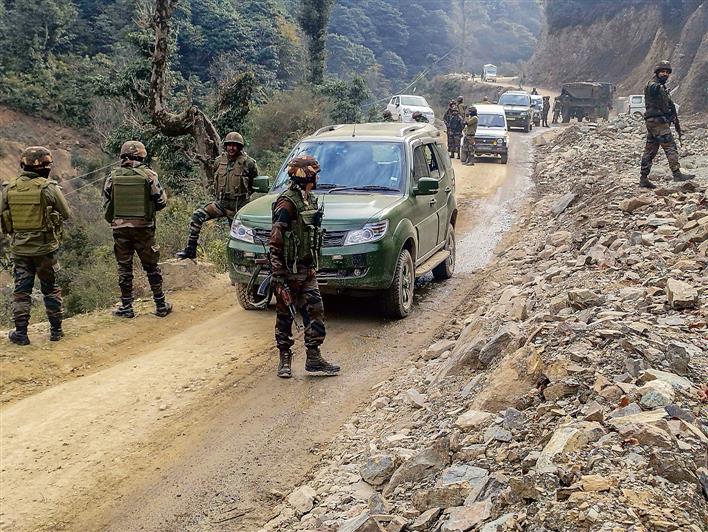The attacks on security forces and the alleged custodial deaths are a setback to the investment made in border management over the years.


There seems to be no let-up in intermittent attacks on security personnel in the Rajouri-Poonch area along the Pir Panjal mountain range that separates the homogenous Kashmir valley from the geographically, religiously and ethnically heterogeneous region of Jammu. The responsibility for the attacks, like in previous cases, has been claimed by the People’s Anti-Fascist Front, which reportedly emerged in 2019.
Since 2019, the militants’ strategy has been to carry out targeted killings in the Valley and inflict losses on security personnel in Rajouri and Poonch districts. On December 21, four Army personnel were killed in an ambush at a spot between Dera Ki Gali and Bafliaz. A total of 59 people — 24 security personnel, seven civilians and 28 terrorists — were killed in Rajouri-Poonch in the past year. Psychological warfare is a component of the militant strategy, which is reflected in the fact that attackers use body cameras to film attacks and then upload videos on social media. The mutilated bodies of soldiers, along with captured weapons, are frequently shown on social media platforms, accompanied by propaganda audios.
Unlike Kashmir, where the terrain consists of plains and a road network has been built, the transportation system in Rajouri-Poonch is underdeveloped. Therefore, the formulation of an effective counter-terrorism strategy will have to factor in the new set of challenges. By the mid-1990s, as detailed in my book Militancy in Jammu and Kashmir: The Uncovered Face, spanning the period from 1989 to 2007, the challenge intensified for the security forces in the religiously heterogeneous Rajouri-Poonch area as there was a greater presence of militants who did not speak Kashmiri, and they had started establishing their bases there.
Rajouri-Poonch is an extension of Pakistan-occupied Kashmir (PoK) in terms of ethnicity and geography. The only difference between the two areas in demographics is the presence of a significant number of Hindus and Sikhs, many of whose families migrated from across the Line of Control (LoC) in 1947; they are living majorly in Rajouri and Poonch towns in an otherwise Muslim-majority region. In PoK, there are no non-Muslims. In August 1965, many of the pockets in this belt were captured by Pakistani infiltrators as part of their Operation Gibraltar, said to be the brainchild of the Pakistani officer in command of the region across the LoC, Maj Gen Akhtar Hussain Malik. Many Muslim families had also escaped across the LoC after the Indian Army re-established control, particularly in border areas of Poonch.
After 1990, it was always impossible to completely sanitise the surrounding peaks to facilitate Army movement. Road-opening patrols became a crucial part of the strategy since the mid-1990s. Several mid-level members of the official machinery have been ambushed by militants in the region in the past two decades. No doubt, the arduous terrain is a constant. However, one cannot ignore the failures in one of the most militarised areas of the subcontinent due to its proximity to the LoC. The label of ‘foreign militants’ from Pakistani Punjab and PoK does not hold true in Rajouri-Poonch as militants coming from across the LoC are largely from the same ethnic and linguistic stock. This ensures easy assimilation. That is why the strategy of winning over the local community is at the heart of effective tactics.
A key initiative was taken by then PM Indira Gandhi, who realised the potency of the approach as part of the efforts to beef up border security. In 1976, she participated in a Gujjar conference in J&K as part of the outreach to the Gujjar-Bakarwal community, one of the main communities which live in this area. Over time, there has been a concerted effort to forge strong bonds between J&K Gujjars, who are Muslims, and Hindu Gujjars, particularly from Rajasthan and the areas around Delhi. This endeavour aims to secularise the Gujjar identity.
In 1991, Gujjars-Bakarwals were granted Scheduled Tribe (ST) status and that solidified their support against terrorism, particularly in the elite sections of the community. A number of serving IAS and IPS officers, coming from the Gujjar community, were direct beneficiaries of this decision. The multi-pronged approach yielded more dividends as the Gujjars in the area collaborated with security personnel, contributing to cleansing the region of the ranks of a terrorist outfit, Lashkar-e-Taiba. One of the Gujjar groups hailed from Bafliaz, and specifically, the Marrah hamlet, which is not far from the area where the recent attack occurred. After the attack, some community members were allegedly picked up by the Army on the suspicion that they were working for the militants; three of them died in custodial torture. The continuing attacks on security personnel and alleged custodial deaths are a setback to the investment made in border management over the years in an area that had almost become militancy-free two decades ago.
To understand the present, one cannot discount the overall context. Since the abrogation of Article 370, a number of ill-thought announcements disturbed the delicate societal equilibrium of the region. One of them was granting ST status to the Pahari-speaking community, a diverse group that includes upper-caste Muslims as well as Hindus, brought together by a shared language. An impression spread among the strongly-knitted Gujjar-Bakarwal community that the decision was detrimental to them. Also, the feedback of the political class to sensitise the security apparatus has been ominously missing since J&K has not had a legislative Assembly for the past five years. The official claim is that around 25 militants are active in the region, but it doesn’t adequately explain why substantial losses are being inflicted. In an environment of militancy, the political class is always well aware of the happenings on the ground. It is also able to better contextualise the information as it is attuned to the ground reality. And when the macro contours of decision-making are determined in the national capital, there appears to be a void in terms of policy execution and calibration.
In a nutshell, addressing the security challenge in Rajouri-Poonch requires more than just a military approach; it must be embedded in local politics and a delicate societal equilibrium. Security, after all, is never solely a military problem.
